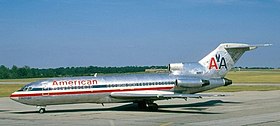American Airlines Flight 625
Coordinates: 18 ° 20 ′ 16 ″ N , 64 ° 57 ′ 31 ″ W.
| American Airlines Flight 625 | |
|---|---|
|
N1963, the misfortune machine |
|
| Accident summary | |
| Accident type | Roll over on landing |
| place |
Harry S Truman Airport , Saint Thomas , US Virgin Islands |
| date | April 27, 1976 |
| Fatalities | 37 |
| Survivors | 51 |
| Injured | 40 |
| Aircraft | |
| Aircraft type | Boeing 727-100 |
| operator | American Airlines |
| Mark | N1963 |
| Departure airport |
TF Green Airport , Providence , Rhode Island , United States |
| Stopover |
John F. Kennedy International Airport , New York , United States |
| Destination airport |
Harry S Truman Airport , Saint Thomas , US Virgin Islands |
| Passengers | 81 |
| crew | 7th |
| Lists of aviation accidents | |
American Airlines flight 625 was a passenger flight operated by American Airlines , which ran from Providence , Rhode Island to Saint Thomas in the US Virgin Islands . On April 27, 1976, when landing at Harry S Truman Airport in Saint Thomas, an accident occurred when the aircraft shot past the 1,400-meter-long runway and was destroyed in the process. The accident killed 37 people. 39 people were injured on board and one more on the ground.
Plane and crew
The aircraft involved in the accident was a Boeing 727-100 with the aircraft registration number N1963. The aircraft had been in service with American Airlines since December 1967 and at the time of the accident had completed 21,926 flight hours. Boeing 727-100 machines were the heaviest aircraft approved for landing at Saint Thomas. These machines were only allowed to land from the sea (from the west).
The crew included flight captain Authur J. Bujnowski (54 years old, more than 22,000 flight hours, including more than 10,000 on a Boeing 727), first officer Edward Offchiss (36 years old, 8,000 flight hours, of which 2,500 on a Boeing 727) and flight engineer Donald Mestler (45 years old, 9,500 Flight hours, 8,000 on a Boeing 727). All three members of the cockpit crew knew the airport of Saint Thomas, Bujnowski made 154 landings here before the accident, Offchiss 38 and Mestler 125.
the accident
The Boeing 727 was launched at 11:00 EST (16:00 UTC ) after a scheduled stop from John F. Kennedy International Airport of New York . The flight to the Caribbean island was uneventful. Flight engineer Mestler prepared a landing data card for Captain Bujnowski , on which a landing weight of 125,000 pounds (≈ 56.7 t ), a position of the landing flaps at 30 ° and a touchdown speed of 120 knots (≈ 222 km / h) was assumed .
At 15:04 AST (19:04 UTC), Captain Bujnowski began the approach for landing. The air traffic control had to land under the rules for visual flight released, but Bujnowski opted for a landing with the instrument landing system and planned with the details of started by Mestler Landing Datacard .
Just before touchdown to Bujnowski decided to go-around when he realized that the machine was not to bring in time for the touchdown. Nevertheless, the plane touched down AST at 3:10 p.m. and sped down the runway. The pilots tried to take off, but then stopped after five seconds. They only used the brakes about 200 meters before the end of the runway. The machine destroyed the instrument landing system's landing course transmitter antenna, breached the airport fence, crossed a street wrecking several vehicles, and stalled on the grounds of a gas station and next to a rum warehouse. The impact and the outbreak of fire killed 35 passengers and two flight attendants and 40 other people (39 passengers and a driver) were injured, some seriously.
examination
The National Transportation Safety Board led the investigation into the accident.
The investigators came to the conclusion that the accident occurred as a result of an operating error on the part of the master; this did not follow the procedures established by the airline for landing on Saint Thomas. In the prevailing wind conditions (wind force 2 from the southeast), these provided for a position of the landing flaps at 40 °. Due to the position at 30 °, the landing distance of the Boeing was extended.
Effects
American Airlines stopped flying to Saint Thomas airport after the accident until the runway was extended. Instead, the airline's planes landed at Henry E. Rohlsen Airport on the neighboring island of Saint Croix , which had a longer runway.

